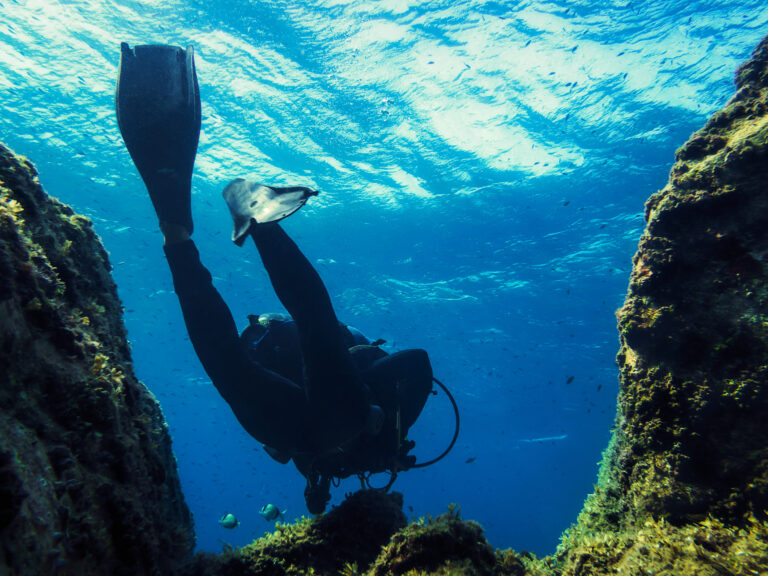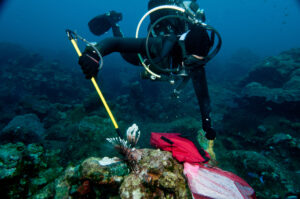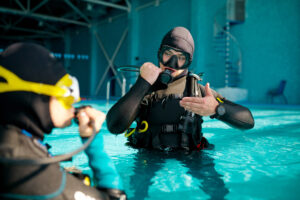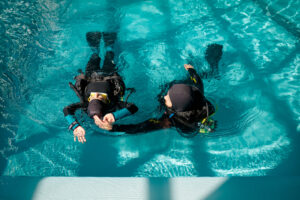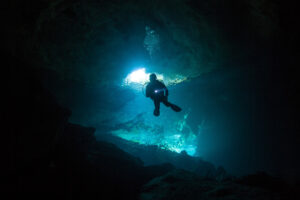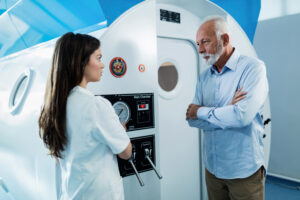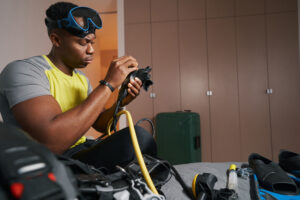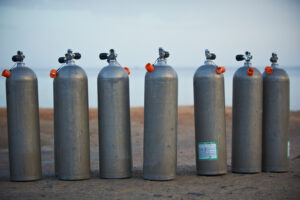What is a Automatic Diluent Valve (ADV)?
The Automatic Diluent Valve (ADV) is a critical component in the configuration of modern rebreather systems used in scuba diving. This device automatically adds diluent gas to the breathing loop to maintain the correct volume and optimal gas mixture, ensuring the diver’s buoyancy and safety at varying depths. The importance of the ADV in facilitating longer, safer dives cannot be overstated, making it an essential study for divers and technicians alike.
Historical Development
Rebreather technology, which recycles exhaled gases, has evolved significantly since its inception, with the development of the Automatic Diluent Valve marking a significant milestone. Originally, rebreathers were manual systems requiring divers to manually add gases to maintain the loop volume and correct mix. The introduction of the ADV provided a leap forward by automating this process, thus enhancing safety and ease of use.
The concept of an automatic addition valve emerged in the early 1990s, integrating with the burgeoning popularity of technical and recreational rebreather diving. Its development paralleled advancements in dive computer technology, which allowed more precise monitoring and control over the breathing gas mixtures and decompression models. Over the years, the ADV has seen various enhancements, from improvements in reliability and responsiveness to integration with digital control systems, significantly shaping the dynamics of rebreather diving.
Technical Description
The Automatic Diluent Valve is ingeniously designed to operate seamlessly within the rebreather system. At its core, the ADV consists of a valve mechanism that is triggered automatically when the pressure within the breathing loop falls below a preset threshold—commonly due to exhalation or changes in ambient pressure as the diver changes depth.
Components of an ADV
The main components include:
- Valve Mechanisms: These are typically spring-loaded and are calibrated to respond to specific pressure changes.
- Connection to Gas Supply: The ADV is connected to a diluent gas cylinder, which is a mix typically safer at depth, such as a helium and oxygen mixture, to prevent narcosis and oxygen toxicity.
- Activation Process: Activation is usually triggered by a decrease in loop volume, sensed as a drop in pressure, which then mechanically opens the valve until the loop pressure stabilizes.
This automatic functionality differentiates it significantly from manual addition systems, where the diver must actively monitor and adjust the loop volume. The automation enhances dive safety by ensuring the gas mix remains breathable and prevents the loop from collapsing, which can cause CO₂ buildup—a dangerous situation underwater.
Functionality and Usage
In operation, the ADV’s role is multifaceted. Primarily, it ensures that the loop maintains a constant volume, compensating for the compression of the breathing loop that occurs as the diver descends and the increase in volume on ascent. By automatically adjusting the gas volume, the ADV assists in managing buoyancy—an essential skill in scuba diving, impacting both safety and the ease of underwater navigation.
The ADV is particularly crucial during the initial descent, when manual dexterity and attention may be compromised as divers adjust to their underwater environment. It also plays a vital role in emergency situations, such as sudden depth changes due to equipment failure or unexpected environmental conditions, by maintaining the gas mixture’s integrity without diver intervention.
Advantages of Using an ADV
The use of an ADV in rebreathers offers significant advantages:
- Enhanced Safety: Automatically maintaining the optimal gas mixture and loop volume reduces the risk of hypoxia (low oxygen levels) and hypercapnia (high carbon dioxide levels), common dangers in manual systems.
- Improved Convenience: Divers can focus more on their surroundings and less on their equipment, making dives more enjoyable and less stressful.
- Increased Dive Time: Efficient gas management contributes to longer dive times by optimizing consumption and reducing the need for frequent manual adjustments.
These advantages underline why the ADV is regarded as a critical upgrade in rebreather systems, contributing significantly to the popularity and accessibility of rebreather diving within the broader diving community.
Types of ADVs
The market offers a variety of ADVs, each designed to meet specific diver needs and rebreather configurations. Manufacturers have developed distinct models that cater to both recreational and technical divers. Some prominent ADV models include those made by leading rebreather manufacturers such as AP Diving, Hollis, and Poseidon, among others.
Features of Different ADV Models:
- AP Diving: Known for its reliability and easy integration with the Buddy Inspiration rebreathers, AP Diving’s ADVs are favored for their robust performance and straightforward maintenance.
- Hollis: Hollis ADVs are designed for versatility, compatible with a range of rebreathers and known for their precise flow rates and durability under extreme conditions.
- Poseidon: Offering ADVs with highly responsive valve mechanisms, Poseidon’s models are engineered for seamless performance, particularly in their closed-circuit rebreathers.
The technological advancements in these models often include enhanced sensitivity to pressure changes, greater resistance to wear under saltwater conditions, and compatibility with a broader range of gas mixtures. The comparative analysis of these ADVs reveals variations in flow rates, ease of maintenance, and initial setup complexities, which can influence a diver’s choice depending on their skill level and diving conditions.
Installation and Maintenance
Proper installation and maintenance are critical for the effective operation of the ADV. Installation typically involves integrating the ADV with the rebreather’s breathing loop, ensuring secure connections to both the diluent cylinder and the breathing circuit. Manufacturers provide detailed manuals that guide divers through this process, though many divers opt for professional assistance to ensure optimal setup.
Maintenance Tips:
- Regular Checks: Divers should routinely inspect the ADV for signs of wear, corrosion, or debris accumulation, which could impair its function.
- Cleaning: Post-dive, it is essential to rinse the ADV with fresh water to remove salt, chlorine, or other contaminants.
- Service Intervals: Following the manufacturer’s guidelines for service intervals ensures the ADV remains in good working condition. This typically includes professional inspections and replacement of worn parts.
Common issues during maintenance include valve sticking, which can often be resolved by cleaning or replacing specific components. For troubleshooting, most manufacturers offer detailed guidance and support, often available through dedicated customer service teams.
Safety Considerations
Safety is paramount in diving, and the ADV contributes significantly to diver safety by ensuring the stability of the breathing loop’s volume and gas mixture. However, reliance on mechanical devices entails inherent risks, and divers must be aware of these when using ADV-equipped systems.
Potential Risks and Mitigation:
- Mechanical Failure: An ADV can fail to activate if improperly maintained or damaged. Regular maintenance and pre-dive checks are essential to mitigate this risk.
- Improper Configuration: Incorrect installation or adjustment can lead to inadequate gas flow, potentially leading to dangerous situations. Divers should always follow the installation procedures recommended by the manufacturer and consider professional setup.
Safety protocols for using an ADV involve thorough training on its operation, understanding the manual override functions (if available), and practicing emergency procedures in controlled environments. Divers are also advised to dive within their certification limits and regularly practice skills related to equipment management.
Impact on Diving Practices
The introduction and widespread adoption of the ADV have had a profound impact on rebreather diving practices. Its automation has made rebreather diving more accessible to a broader range of divers by reducing the workload and complexity of managing the breathing loop manually.
Contributions to Extended Range and Technical Diving:
- Longer Dives: By efficiently managing gas mixtures, the ADV allows for extended dive times, crucial in technical and scientific diving operations.
- Deeper Dives: The precise control over gas mixtures makes deeper dives safer and more feasible, particularly in exploring wrecks and natural underwater formations.
Case studies from expeditions utilizing ADV-equipped rebreathers often highlight the device’s role in achieving significant diving feats, such as record-breaking depths and prolonged underwater endurance. These examples not only demonstrate the capabilities of ADV technology but also inspire continuous improvement and innovation within the industry.
Key Takeaways
The Automatic Diluent Valve (ADV) represents a significant advancement in rebreather technology, enhancing both the safety and efficiency of scuba diving. By automating the addition of diluent gas to maintain optimal breathing loop volume and mixture, the ADV has transformed rebreather diving from a niche activity into a more accessible and safer endeavor for a broad range of diving enthusiasts.
ADV technology not only contributes to the practical aspects of diving by simplifying equipment management and expanding the possibilities for extended and deep dives, but it also plays a crucial role in enhancing diver safety. The automated management of gas mixtures and loop pressure reduces the risk of hypoxia and hypercapnia, common dangers in manual rebreather systems. This automation allows divers to focus more on their surroundings and the purpose of their dive—whether for exploration, photography, or scientific research—rather than their equipment.
As rebreather technology continues to evolve, the role of the ADV is likely to expand further, driven by advances in material science, sensor technology, and digital control systems. The future may see ADVs that are even more responsive, reliable, and integrated with other dive safety systems, potentially incorporating artificial intelligence to predict and react to diver behavior and environmental changes.
The Automatic Diluent Valve is more than just a component; it is a testament to the ongoing innovation in dive technology. It epitomizes how engineering can interplay with human skill and environmental awareness to push the boundaries of what is possible under the water. As we look to the future, the evolution of the ADV will undoubtedly continue to influence the safety standards, capabilities, and popularization of rebreather diving within the global diving community.

